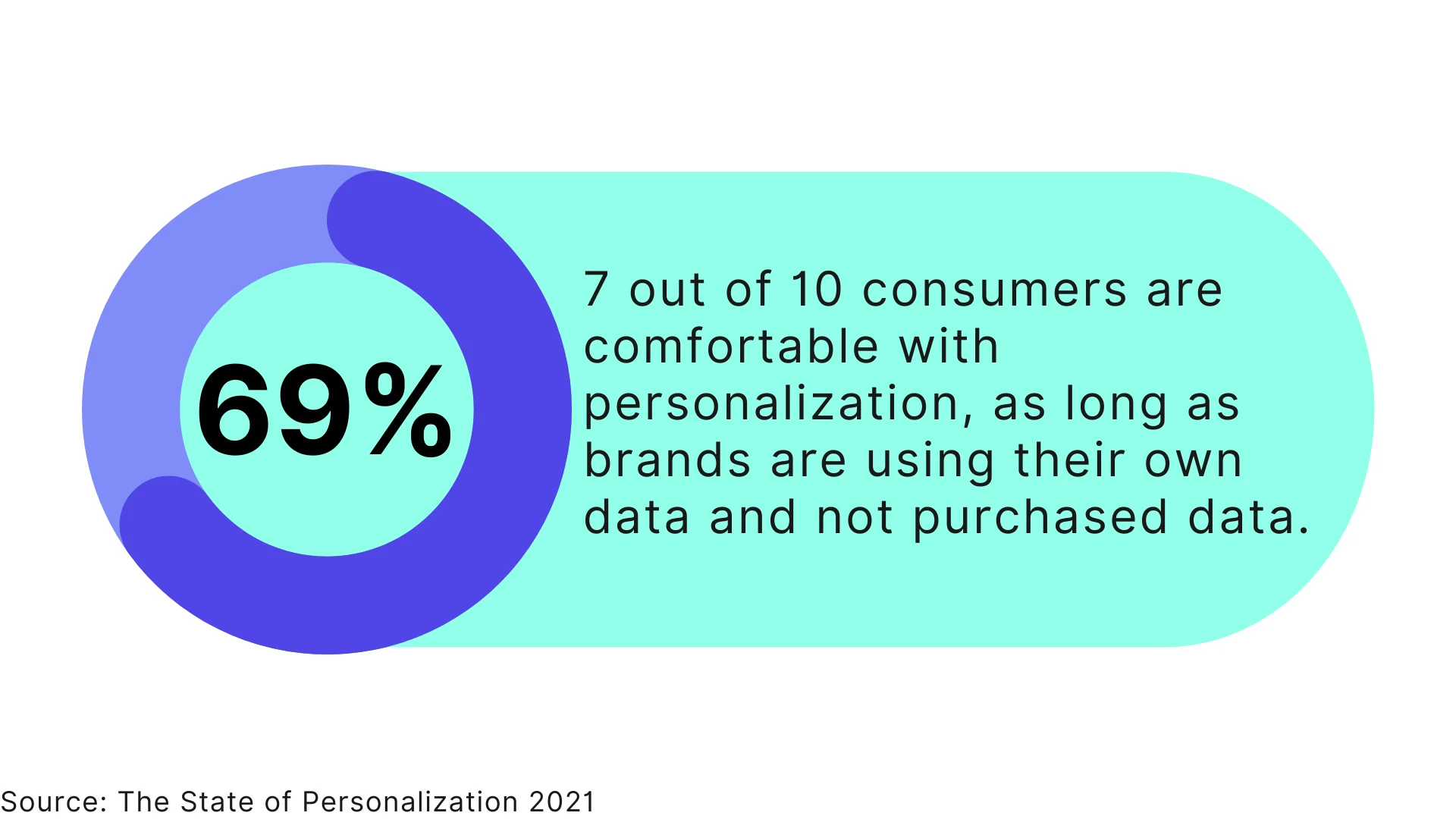- Personalization
9 Common Personalization Challenges (And How to Overcome Them)


As a business, you are always looking for new and innovative ways to engage with your customers. Personalization has become a critical factor in achieving this goal, as it allows you to create unique and one-to-one experiences for each individual.
However, personalization can be tricky – there are many challenges that can prevent you from getting it right.
And many businesses face similar personalization challenges.
About two-thirds (63%) of digital marketing leaders said they continue to struggle with personalization, consulting firm Gartner found in a survey of 350 executives.
It can be difficult to create a truly personalized experience for every customer, but with the right strategy in place, it’s definitely achievable.
In this blog post, we will explore nine of the most common personalization challenges and discuss how to overcome them.
9 Common Personalization Challenges That Prevent Scaling
1. Data Challenges
In order to create a personalized experience for your customers, you need to have access to their data. Customer data is the key to understanding what each individual customer wants and needs. And it's essential for powering marketing personalization engines.
That's why marketers are always looking for new and innovative ways to collect it.
But what happens when you have too much of it? Or when it's not accurate?
Here are the primary data challenges:
Huge Volumes of Customer Data
According to Google, an average person switches between three devices to complete a task. And they use over 10 channels to communicate with businesses.
And that number is only going to grow in the coming years.
As customers, we generate an incredible amount of data — some of which can be incredibly useful for businesses. But, not all customer data is created equal.
In order to make the most of customer data for personalization, businesses need to focus on identifying and extracting the most valuable information.
Personalization's purpose is not to use all of the customer data. Your objective should be to utilize as little data as possible to tailor your material for each prospect as a business.
Knowing what data is most important to you is crucial, yet filtering through mountains of data to discover valuable information is challenging.
Bad Quality Data
According to The Clear Path to Personalization report, half of the marketers tell data quality is one of the primary challenges to effective personalization.
Moreover, Marketing Sherpa asserts that 2.1% of customer data goes bad every month - which means almost one-fourth of the customer data every year.
Bad data means:
outdated data
irrelevant data
incorrect data
Because of bad data, you might target the customers with the incorrect message and content, resulting in unsatisfactory experiences that drive users off.
Privacy and Regulations
As companies strive to create a more personalized experience for their customers, they are also facing new challenges when it comes to data privacy and regulations.
Trying to balance the need for customer data with the need to protect user privacy can be difficult, but it's important for businesses to find a way to do both. Failing to do so could lead to decreased trust from customers and potential fines from regulators.
However, recent research shows that 69% of consumers say they appreciate personalization, so long as it’s directly based on data they’ve shared with a business.

Therefore, businesses that gather, manage, and store data responsibly have nothing to worry about. Privacy rules and regulations only threaten personalization based on improperly gathered and maintained data.
People will be more willing to give over their data if they can feel secure about its use, where it is going, and who has access to it.
And this can only help with personalization.
Non-Unified Customer Profiles
Customers are everywhere. They come to you through different channels, visit your website more than once, and interact with a variety of digital touchpoints.
Without a unified view of the customer, you cannot create relevant and timely experiences for your customers across all channels.
A unified customer profile is critical for making smart decisions and delivering the right message at the right time.
To obtain a clearer understanding of who your customers are, marketers must compile customer data from various sources into a complete customer profile.
2. Segmentation Challenges
Segmentation is one of the most important steps in effective personalization. By isolating and targeting specific groups, businesses can improve the customer experience and increase their chances of conversion.
However, this is easier said than done.
As businesses strive to provide a more personalized experience for their customers, they are confronted with the challenge of segmenting their customer base.
Creating meaningful segments and accurately targeting customers within each one is critical to the success of any personalization strategy.
But as any marketer knows, it can be difficult to navigate all the complexities involved in doing this effectively. There are a lot of factors to consider, and it's important not to overlook any of them.
It's necessary to divide your audience into groups that share common characteristics in order to create relevant and personalized messages.
Without audience segmentation, it’s challenging to get desired results from your personalization efforts.
3. Talent, Skills, and Organizational Challenges
When we talk about personalization, we usually think about how to collect data, which data to collect, the best technology stack, the best way to segment users, etc. However, we usually forget the most important factor that makes a huge difference with all these data and technology:
People.
And collaboration among different departments.
Gartner's research found that organizational collaboration and capabilities are key differentiators between average and above-average performance in personalization.
However, in many businesses, different teams work with different sets of tech stacks such as CRM, analytics, marketing automation, etc. Therefore, the lack of an aligned tech stack across teams makes it more difficult to create effective personalization efforts.
In order to deliver the best personalization experience for customers, companies need to invest in people and create a collaborative mindset between teams.
This means that all departments in the organization need to be on the same page and working together. Marketing, sales, customer service, and operations all need to be aligned in order to create a consistent and accurate customer experience.
By collaborating and communicating with each other and sharing a common goal, you'll better understand what your customers want and how to give it to them.
4. Real-Time Delivery Challenges
Simply put, real-time personalization is delivering a customer experience that is tailored to their specific wants and needs in real-time.
In order to deliver true personalization, you need to have a system that creates real-time experiences for your customers. This means that as soon as a customer interacts with your brand, their experience should be tailored specifically to them.
In a world where customers are inundated with advertisements and messages, the ability to provide a personalized experience in real-time is more important than ever. By understanding what customers want and need in real-time, businesses can create a more meaningful connection with their customers and boost loyalty and engagement.
Most companies are still struggling to do this effectively because it requires the seamless orchestration of data collection, segmentation, cross-channel profile synchronization, and execution.
There are two major reasons for real-time delivery challenges:
lack of organizational alignment
lack of orchestration between tech stack
Although real-time personalization seems very hard to achieve, it’s possible with the right tools and organization alignment.
5. Omnichannel Delivery Challenges
Today, most businesses are looking to improve their customer experience (CX) to stay ahead of the competition. And while many strategies exist for achieving this, omnichannel personalization is one of the most promising approaches.
This involves delivering a personalized experience to customers regardless of their channel to interact with a company.
However, there are several challenges that businesses must overcome in order to successfully implement omnichannel personalization.
The main challenge for omnichannel personalization is the lack of data synchronization across channels.
However, it’s not the only challenge. Since each department in business concentrates on its own business goals and objectives, the data from multiple departments is often kept separate and isolated.
Therefore, the omnichannel personalization challenges are very similar to real-time personalization delivery challenges:
lack of organizational alignment and communication across teams
lack of orchestration between tech stack
lack of unified customer profile and data synchronization across channels
Understanding and overcoming these challenges is key to delivering an effective and personalized experience for customers across all channels.
6. Technology Challenges
Another major challenge for personalization is selecting the right technology stack.
As companies race to personalize their customer interactions, they realize that this is not as easy as it sounds. Technological challenges abound, from data management to integrating different channels and systems.
Even when the technology is in place, translating customer data into useful and actionable insights is no small feat. And then, there is the challenge of putting those insights into practice in a way that feels genuine and personalized.
All of this means that companies need to invest time and resources into getting personalization right.
There are many different options, and it can be difficult to determine which ones will work best for your needs.
Not all personalization tools are created equal; some offer more functionality than others and may be better suited for your business goals.
So how do you know which one to choose?
When you’re choosing a personalization tool, be sure that the personalization tool is compatible with your requirements in terms of:
omni/cross channel personalization capabilities
customer segmentation
easy and seamless integrations with other tools
real-time personalization and optimization
testing and experimentation
predictive and rule-based personalization opportunities
customer data management and unified profile creation
Read: How to Choose the Right Personalization Tool for Your Business
Read: 8 Questions to Ask Before You Choose Your Personalization Tool
7. Measurement Challenges
How do you know if your personalization efforts are working?
This is one of the major challenges for marketers today.
Measuring the results of your personalization efforts can help you determine what's working and what needs to be improved. But measuring metrics can also be a challenge, especially when you're dealing with all the data that's available today.
By taking the time to measure your results carefully, you'll be able to make better decisions about how to personalize your content and improve your overall business performance.
However, measuring the success of personalization initiatives can be a daunting task. There are a number of factors to consider, including which metrics to use and how to track them.
Because personalization requires a longer time to showcase its effects, and it is difficult to quantify "customer attachment" or "customer trust," marketers struggle to measure the effectiveness of their personalization initiatives.
8. Scalability Challenges
As your business grows, the need for more personalized customer experiences also increases. But when it comes to scaling personalized experiences, many businesses hit a wall.
Why is scalability such a challenge for personalization?
Achieving true personalization is not easy – it's a complex process that involves:
analyzing huge amounts of customer data,
content design and creation for each customer group, and
effective usage of communication channels.
Luckily, there are ways to overcome this challenge, and businesses that manage to do so will be well on their way to true personalization nirvana.
Artificial Intelligence (AI) can provide the scalability needed to ensure that every customer receives a unique, personalized experience – even at a massive scale. AI can automate the process of collecting and acting on data, making it possible to deliver a personalized experience at scale.
9. Getting Started Challenges
Many businesses struggle with knowing where to start when it comes to personalizing their interactions with customers.
Even if you have a good understanding of what personalization is and how it works, figuring out how to actually implement it can be a daunting task.
This challenge is only compounded by the fact that there are so many different ways to go about personalizing the customer experience.
To be able to deliver the right personalization, first, you need to understand the fundamentals of personalization:
First of all, you need to understand that personalization starts with customer segmentation.
To create customer segments, you need to have customer data. The second backbone of the fundamentals of personalization is having and understanding customer data.
The third point is understanding your personalization maturity level.
The next point is understanding and deciding the personalization channels. Usually, when we talk about personalization, we think about web personalization. However, there are different channels for personalization.
The last point in the fundamentals of personalization is understanding the relationship between personalization and experimentation. You must always keep in mind that personalization is a process. To deliver the best possible customer experience each and every time, you need to create continuous experimentation within the personalization process.
The Bottom Line
As a business, you understand the importance of personalizing your customer's experience. After all, it's what sets you apart from the competition and keeps your customers coming back for more.
But despite your best efforts, there are some common personalization challenges that can sometimes stand in your way - especially if you're unsure where and how to start.
In this post, we take a look at nine of those challenges and offer tips on how to overcome them.
Learn how to deliver unique and personalized customer experiences to increase conversions

